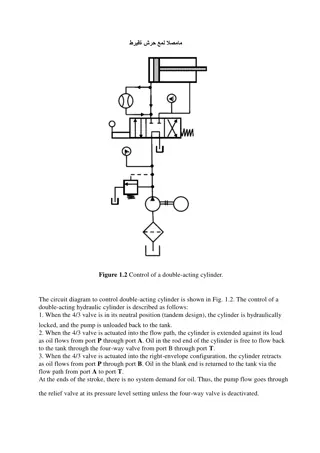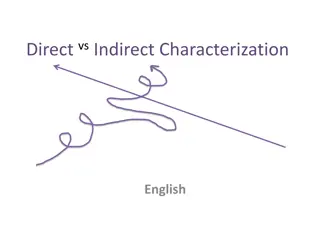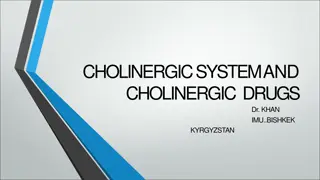Understanding Indirect Acting Cholinergic Drugs: Mechanism, Classification, and Clinical Applications
Explore the world of indirect acting cholinergic drugs, also known as anticholinesterases, which work by inhibiting acetylcholinesterase to increase acetylcholine levels at cholinergic receptors. Learn about their mechanisms of action, classification, kinetics, dynamics, uses, adverse effects, contraindications, and the management of organophosphates toxicity. Discover important notes and considerations while delving into these vital pharmaceutical agents.
Download Presentation

Please find below an Image/Link to download the presentation.
The content on the website is provided AS IS for your information and personal use only. It may not be sold, licensed, or shared on other websites without obtaining consent from the author. Download presentation by click this link. If you encounter any issues during the download, it is possible that the publisher has removed the file from their server.
E N D
Presentation Transcript
Editing File Indirect acting cholinergic drugs Objectives: Classification of indirect acting cholinomimetics Mechanism of action, kinetics, dynamics and uses of anticholinesterases Adverse effects & contraindications of anticholinesterases Symptoms and treatment of organophosphates toxicity. Important Notes Extra
Indirect Cholinomimetics Also called Anticholinesterases Anticholinesterases prevent hydrolysis of Ach by inhibiting acetyl cholinesterase thus, increase Ach concentrations and actions at the cholinergic receptors (both nicotinic and muscarinic). Acetylcholine binds to acetylcholinesterase at two sites, anionic site and esteric site, then the enzyme somehow breakdown the acetylcholine into acetic acid and choline. In order to inhibit this enzyme we need to create a substance that is similar to acetylcholine either in both sites or even one site. (Similar structure) M.O. A Reversible anticholinesterases Irreversible anticholinesterases Durat ion of actio n Short Acting Intermediate acting Long Acting (Carbamates esters) e.g. Physostigmine, Neostigmine, Pyridostigmine. (Alcohols) e.g. edrophonium. (Phosphates esters) e.g. insecticides, gas war e.g. Ecothiophate & Isoflurophate. Using those drugs leads to death Drug s Classi ficati on Binds to two sites of cholinesterase enzyme. All polar and synthetic except physostigmine. used as insecticides(malathion) or nerve gases (sarin) . Form very stable covalent bond with cholinesterase . All phosphates are lipid soluble except Ecothiophate which is polar Forms weak hydrogen bond with acetylcholineste rase enzyme Feat ures CNS actions: (excitation leads to convulsion leads to respiratory failure leads to coma). e.g. physostigmine & phosphate ester Revise the nicotinic and muscarinic actions from (Direct Acting) lecture, it is the same! They act on both Muscarinic and nicotinic receptors. Some has CNS effect only the lipid soluble drugs Phar macol ogical action s
Reversible indirect drugs: Drug Edrophonium Neostigmine Physostigmine MOA Reversible anticholinesterase Has muscarinic & nicotinic actions (prominent on GIT & urinary tract) Special action Reversible anticholinesteras e. Has muscarinic, nicotinic action Reversible anticholinesterase and forms weak hydrogen bonds. NOT absorbed orally, given by injection. Bc its polar Alcohol (ionic bonds, not esters), so its polar Short duration of action (5-15 mins) Esters prolong the effect of the drug Good oral absorption. Tertiary ammonium compound. Non polar. Good lipid solubility. Cross BBB (has CNS effects) P.K Can be used orally Quaternary ammonium comp. Polar compound No CNS effect Uses Used only for the diagnosis of myasthenia gravis due to its limited duration of action. Used to differentiate between Cholinergic crisis and Myasthenia Gravis because the drug will make the crisis worse. Treatment of myasthenia gravis. Longer duration Paralytic ileus & Urinary retention. Competitive neuromuscular blockers intoxication by increasing the level of Ach. Thus prevent the action of NMBs (Neuromuscular Blocking Agents) Glaucoma. Atropine toxicity (atropine is anticholinergic drug) used in atropine toxicity because atropine has an effect on the CNS. Thus, we need a drug that can clean up atropine from all over the body Not used with Myasthenia Gravis because it was not used on MS patients before Eyelid drop (E) Drop honium Myasthenia gravis Mne moni c - -
Cont. of reversible drugs Donepezil Drugs Is a centrally acting reversible acetyl cholinesterase inhibitor. M4, M5 M.O.A Given orally P.K Used for treatment of dementia of Alzheimer's disease Uses Irreversible indirect drugs: Drug Ecothiophate (Organophosphorous compound) M.O. A Irreversible anticholinesterase Binds to cholinesterase by strong covalent bond P.K Have very long duration of action Aging make bond extremely stable and make treatment difficult from toxicity All are highly lipid soluble except Ecothiophate Uses Used for glaucoma
Cont. of irreversible drugs Org ano ph osp hat e tox icit y Symptoms of organophosphate toxicity Heart : Lung : Severe bradycardia and hypotension. bronchospasm GIT : CNS : Increase motility which lead to cramps and diarrhea CNS effects convulsion , coma and respiratory failure Skeletal muscles : initial twitching of skeletal muscles causing muscle weakness and paralysis. Treatment of organophosphate toxicity Support respiration Cholinesterase reactivators ( Oximes ) Atropine ( to block muscarinic action and CNS effect ) Immediate treatment because delaying makes the bonds more stable Cholinesterase Reactivators (Oximes) Pralidoxime (PAM) Drug Cholinesterase reactivator Acts by regeneration of cholinesterase enzyme Reactivates recently inhibited enzymes before aging M.O.A I.V over 15-30 min for organophosphate intoxication. Uses
Side effects of Cholinergic drugs: Those ADRs are of both INDIRECT and DIRECT acting drugs: Bradycardia Sweating & Salivation Bronchoconstriction Diarrhea Summary Uses of some Cholinergic drugs: Eye: Treatment of glaucoma Pilocarpine (direct muscarinic agonist) Physostigmine Ecothiophate (indirect cholinomimetics) Urinary retention and paralytic ileus: Bethanechol (direct) Neostigmine (indirect) Myasthenia gravis (only indirect cholinomimetics): Pyridostigmine, Neostigmine, Ambenonium Xerostomia: Pilocarpine Cevimeline (Sjogren s syndrome) Alzheimer s disease: Donepezil. (Dementia of Alzheimar s disese)
Chemical structure Administratio n Drugs Actions Kinetics Uses Myasthenia gravis treatment Paralytic ileus Urinary retention Curare toxicity Quaternary ammonium compound Nicotinic muscarinic M, N Neosti gmine Can be used orally -0.5-2hr -polar Good oral absorption, can be used topically in the eye Physos tigmin e Nicotinic muscarinic M, N, CNS Tertiary ammonium compound -0.5-2hr -nonpolar (lipid soluble ) Glaucoma Atropine toxicity Pyridos tigmin e Nicotinic muscarinic M, N Myasthenia gravis treatment - -3-6hr -polar Quaternary Amben onium Nicotinic muscarinic M, N - Myasthenia gravis treatment -4-8hr -polar Quaternary Quaternary (Attach mainly to acetyl cholinesterase by weak hydrogen bond.) Diagnosis of Myasthenia gravis, not for the treatment. Nicotinic muscarinic M, N Edroph onium injection -5-15 min -Polar
Questions MCQs: 1- which one of the following is lipid soluble A)Neostigmine. B)Physostigmine. C)Donepezil. D)Ecothiophate. 2-which one of the following has the shortest duration of action A)Ambenonium. B)Ecothiophate. C)Edrophonium. D)Neostigmine. 3-Which of the following is an anticholinesterase drug that has an effect on the CNS? A)Pyridostigmine. B)Isoflurophate. C)Physostigmine. D)Ambenonium. 4-Which of the following drugs is used in the diagnosis of Myasthenia gravis? A)Edrophonium. B)Ambenonium. C)Neostigmine. D)pyridostigmine. 5-All anticholinesterases have : A)Nicotinic action. B)Muscarinic action. C)Both nicotinic and muscarinic action. D) 1 & 2 action. Answers: 4-A 1-B 5-C 2-C 3-C
Cont.. SAQ: 1)What's the function of indirect cholinergic drugs? prevent hydrolysis of Ach by inhibiting acetyl cholinesterase thus increase Ach concentrations and actions at the cholinergic receptors (both nicotinic and muscarinic). 2)What is the Drug used in treatment of dementia of Alzheimer's disease? Donepezil. 3)How the endrophonium inhibit the acetyl cholinesterase? By attach to acetyl cholinesterase by weak hydrogen bond.
It is not hard, you just made it to the end! Team Leaders: Yazeed Alharbi & Aseel Badukhon Thanks for those who worked on this lecture: Abdullah abdurahman al-asseri Abdulhakim Alonaiq Bader Altamimi Fayez Ghiyath Aldarsouni Maan Abdulrahman Shukr Mohammed alnajeim Omar Alsuhaibani Sultan Omar Almalki Yazeed abdullah alkhayyal Ahmed Lateef Alanzy Adel Alorainy Special thanks to: Rahaf Al-Thnayan Alfahdah Al-Saleem Layla Al-Sabbagh References: Team436 Doctors notes and slides @Pharma4370 pharmacology437@gmail.com























